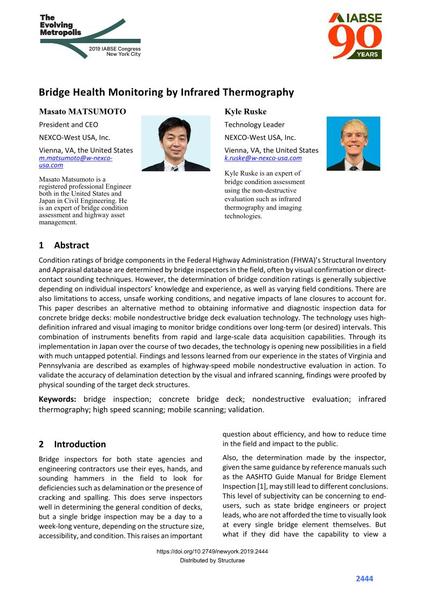Bridge Health Monitoring by Infrared Thermography

|
|
|||||||||||
Bibliografische Angaben
| Autor(en): |
Masato Matsumoto
(NEXCO-West USA, Inc.)
Kyle Ruske (NEXCO-West USA, Inc.) |
||||
|---|---|---|---|---|---|
| Medium: | Tagungsbeitrag | ||||
| Sprache(n): | Englisch | ||||
| Tagung: | IABSE Congress: The Evolving Metropolis, New York, NY, USA, 4-6 September 2019 | ||||
| Veröffentlicht in: | The Evolving Metropolis | ||||
|
|||||
| Seite(n): | 2444-2451 | ||||
| Anzahl der Seiten (im PDF): | 8 | ||||
| DOI: | 10.2749/newyork.2019.2444 | ||||
| Abstrakt: |
Condition ratings of bridge components in the Federal Highway Administration (FHWA)’s Structural Inventory and Appraisal database are determined by bridge inspectors in the field, often by visual confirmation or direct- contact sounding techniques. However, the determination of bridge condition ratings is generally subjective depending on individual inspectors’ knowledge and experience, as well as varying field conditions. There are also limitations to access, unsafe working conditions, and negative impacts of lane closures to account for. This paper describes an alternative method to obtaining informative and diagnostic inspection data for concrete bridge decks: mobile nondestructive bridge deck evaluation technology. The technology uses high- definition infrared and visual imaging to monitor bridge conditions over long-term (or desired) intervals. This combination of instruments benefits from rapid and large-scale data acquisition capabilities. Through its implementation in Japan over the course of two decades, the technology is opening new possibilities in a field with much untapped potential. Findings and lessons learned from our experience in the states of Virginia and Pennsylvania are described as examples of highway-speed mobile nondestructive evaluation in action. To validate the accuracy of delamination detection by the visual and infrared scanning, findings were proofed by physical sounding of the target deck structures. |
||||
| Stichwörter: |
Brückeninspektion Validierung Infrarot-Thermografie
|
||||
